Truly great Facebook ad examples are the result of much trial and error. And unless you’re determined to create a high-performing, 100% original combination of Facebook ad copy and design, you might as well steal from the best, right?
Pablo Picasso is actually quoted as having said, “Good artists borrow, great artists steal.” Whether or not he stole that quote is unknown, but having that quote attributed to him here is all the evidence you need to realize its accuracy.
So don’t feel bad about taking what works and making it your own. And instead of starting from scratch, running A/B tests, and spending weeks or even months tweaking your Facebook ads until you’ve created a high-performing advertisement campaign – start with already proven examples of Facebook ads that work.
We’ve done it here at Customers.ai, plenty of times. And just to prove that we know our Facebook ads pretty well, our Founder, Larry Kim, has been named Search Marketer of the Year by Search Engine Land, PPC Hero, and the US Search Awards on multiple occasions.
Larry is also the Founder of Wordstream, the leading provider of Facebook, AdWords, and keyword tools used by over a million marketers worldwide.
So if you want to know how to come up with a great Facebook ad that converts, you’ve come to the right place!
Here are 10 of the best Facebook ad examples guaranteed to produce a high ROI:
- Messenger ad examples
- Facebook Lead Ad examples
- Video ad examples
- Carousel ad examples
- GIF ads examples
- Product ad examples
- Ads that create a sense of urgency
- Examples of Facebook Canvas ads
- Brand awareness ads examples
- The Greatest Facebook Ad Hack of All-Time
We saved the best for last, so don’t miss it!
Join Today’s Webinar with Larry Kim!
Or Register for the Free Replay
Learn all about NEW 100% Meta-Approved Automation Tools from Customers.ai with a spotlight on features to 10X Instagram & Facebook Engagement and turn social media into a revenue driver for your business.

Facebook Ad Examples #1: Messenger Ads
If you’re looking for cool Facebook ad ideas, look no further than Facebook Messenger ads. Messenger ads are the ultimate way to increase engagement on Facebook with ads.
Facebook Messenger ads present a rare opportunity that savvy digital marketers are taking advantage of.
And that’s because Facebook Messenger ads are different than regular Facebook ads. Most importantly, Messenger ads perform better than normal Facebook ads because they start a more engaging conversation with chatbots.
Here’s an example of a Facebook Send to Messenger ad:
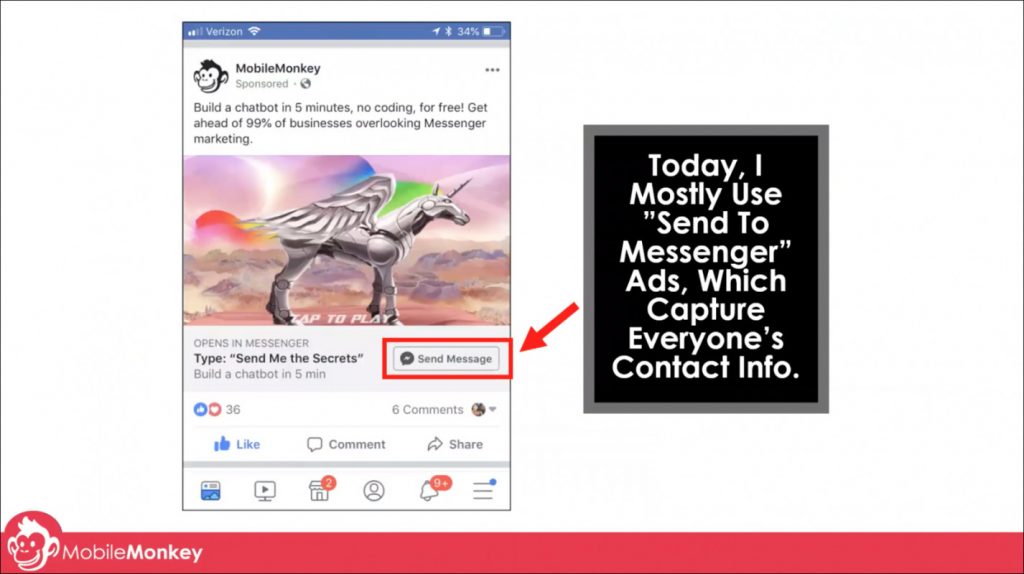
A couple of types of Facebook Messenger ads exist. There’s an ad viewed on any Facebook property that directs traffic to Messenger, like the example above. And then there’s sponsored content that’s native in Messenger.
Another cool thing about Facebook Messenger ad experiences is that they can take place across the Facebook family of apps, including the Facebook newsfeed, Instagram newsfeed, Facebook and Instagram Stories, Marketplace, Messenger, and others.
And Facebook Messenger ads differ from your average Facebook ad because they always lead to a conversational experience between your business the prospect.

Want to experience this Facebook ad example for yourself in Messenger? Click here!
What to know about Facebook Messenger ads:
- Messenger ads outperform other ads by 2X-10X
- Instant lead and data capture
- More features available for personalization
- Automated lead qualification and follow-ups with chatbots
Check out the best Facebook Messenger ad examples of all-time get more great ideas!
Facebook Ad Examples #2: Facebook Lead Ads
Facebook Lead Ads are native to your Business Manager on Facebook. Lead Ads appear on users’ feeds and stories on Facebook and Instagram.
They can help you drive objectives from the top of the funnel, like brand awareness and reach, as well as the bottom of the funnel and customer acquisition.
What’s cool about this Facebook ad example is that the lead forms are pre-populated with user information. Pre-populated forms mean people can submit their contact information with ease, even on a small screen with just a few taps. Which makes Lead Ads great for mobile advertising on Facebook.
Here’s a Facebook Lead Ad example from Sleeknote.

Although you can’t tell from the image, this Facebook Lead Ad is further optimized for quick follow-ups. That means that once someone submits their contact information, webhooks are used to trigger a drip campaign sequence.
Lead ads can take many forms:
- Price quotes
- Demo requests
- Newsletter subscriptions
- Event registrations and more.
But did you know that if you use Facebook Messenger ads that you don’t need lead forms at all?
With Messenger ads, you instantly capture Facebook user data when anyone on Facebook interacts with your ads. This is the most frictionless way to capture leads from Facebook ads there is.
Plus, if you use a chatbot platform like Customers.ai, all of your Facebook lead capture data from Messenger ads is automatically stored for you.
You can find more information on Facebook Messenger ads here: Facebook Messenger Ads
What to know about Facebook Lead Ads:
- Lead Ads do most of the work of filling out contact forms, so people are more likely to complete them.
- To get higher-quality leads, customize your forms to ask for the most important information first.
- Facebook Messenger ads are natural lead capture ads because they don’t require forms of any kind. In addition to your Facebook Lead Ads, try using the many Facebook advertising tools offered by Messenger ads.
Check out this article for more lead generation tools for Facebook and other platforms.
Facebook Ad Examples #3: Video Ads
Facebook users are watching more online videos than ever before. And the best advertisers are finding as many ways as possible to capitalize on that fact.
Here’s a Facebook video ad from Customers.ai that has performed extremely well. Click the play button for the full video ad experience:
Facebook video ads aren’t only a great way to show off your brand’s personality and to connect emotionally with an audience, but they also capture peoples attention.
In fact, viewers spend, on average, 5X longer looking at a video ad than a static image ad.
Additionally, video viewers are more easily targeted, which increases your reach, drives engagement, and boosts conversion rates more than any other form of promotion.
Lastly, Facebook and Instagram both continue to focus aggressively on being video-first platforms. That means you’ll be rewarded for the time and money spent on creating awesome videos for Facebook.
What to know about Facebook video ads
Here are 7 key takeaways you should keep in mind when creating Facebook video ads:
- Continuously check for new video ad examples. Video is very competitive, therefore you’ll constantly find great new video ideas by browsing.
- Experiment a lot. Take note of what’s working and what’s not until you get your KPIs to an optimal level.
- Always optimize for mobile. Both Facebook and users will reward you for this.
- Capture the viewer’s attention within 3 seconds. According to Dennis Yu, a Facebook video ad expert, people choose whether or not they’ll pay attention to a video within the first 3 seconds.
- If you can, try to make all of your video ads last about 15 seconds.
- Test your videos out organically first. If you have a large enough audience, you should be able to get a good idea of whether or not to throw money behind a video. When you see one that’s working, use this article to learn how to boost a post on Facebook to promote your video ad.
Facebook Ad Examples #4: Carousel Ads
Most of you have probably seen or created carousel ads on Facebook. They’re the ads where you can click an arrow to scroll through multiple pictures in a single ad.
Carousel ads are effective not only because they encourage prospects to interact with your ad, but because they just flat out allow you more room for products or portions of your brand story.
But did you know that you can add different types of carousels to Messenger ads as well?
Well, you can. And the great thing about using carousel ads in Messenger is that they’re even more interactive, especially on mobile. Furthermore, there are many different types of content you can choose to add to your carousel ad in Messenger.
In the following example, Customers.ai is presenting different topics of content for the user to choose from:
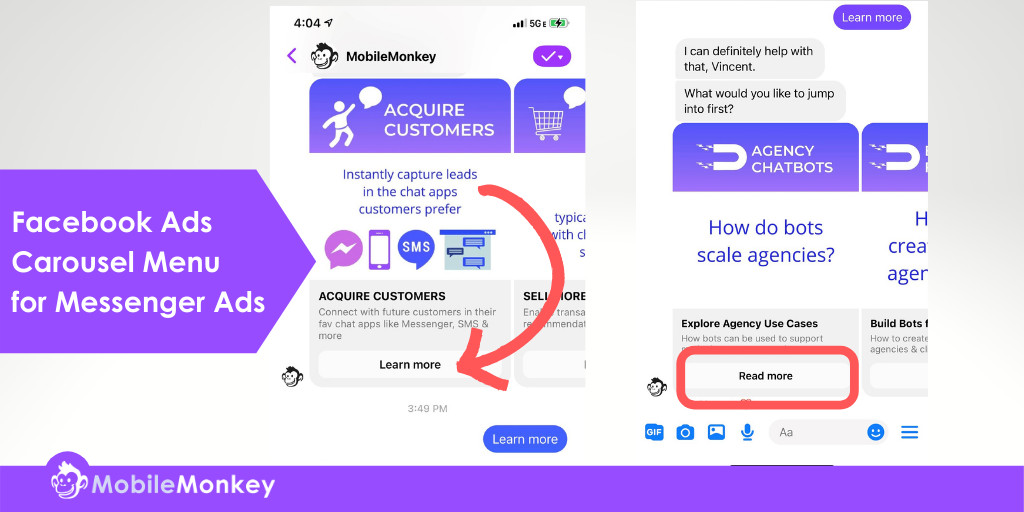
As you can see, if you tap on Learn more in the first of the two images above, the Customers.ai chatbot responds with, “I can definitely help with that, {{First Name}}” and then, “What would you like to jump into first?”
In this example, I chose to learn more about agency chatbots and how to scale a marketing agency with chatbots.
What to know about Facebook carousel ads:
- Users prefer interactive content over stagnant content. Facebook carousel ads are a great way to make your ads more dynamic and interactive.
- If you have a lot of content to share and don’t know what to promote, use a carousel ad. You’ll provide users both options to choose from, as well as learn what content is of most interest to your different audiences.
- You can display up to 10 images or videos on Facebook carousel ads.
- Carousel ads are a favorite among ecommerce advertisers because you can allow users to shop for different products.
Facebook Ad Examples #5: GIF Ad
GIF ads are a mixture of image ads and video ads.
And GIF ads are amazing when it comes to delivering a high CTR (click-through-rate). Here’s the data to prove it:
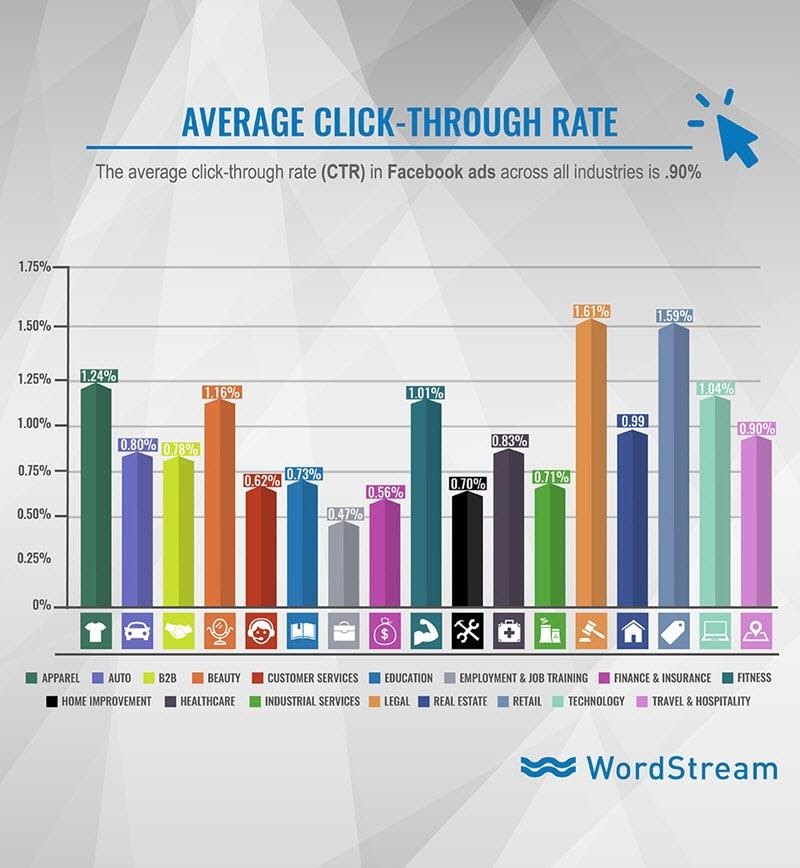
According to WordStream, the average CTR for Facebook ads across all industries is 0.90%.
And according to Facebook, “shorter videos get more complete views.” As we mentioned earlier, a fifteen-second video ad is going to be viewed to completion far more often than videos that run a minute or longer.
This is where GIFs become extremely valuable.
GIFs are eye-catching. They stand out from images (which can feel like white noise) and don’t require the same investment, effort-wise, as video, carousel, and lead ads.
But that’s not even the best part.
You can repurpose existing video assets to create awesome Facebook ads with higher engagement.
One thing you may have noticed in our #1 Facebook ad example was the robot.
Well, that’s not a static image. Here’s the screenshot again as a reminder:
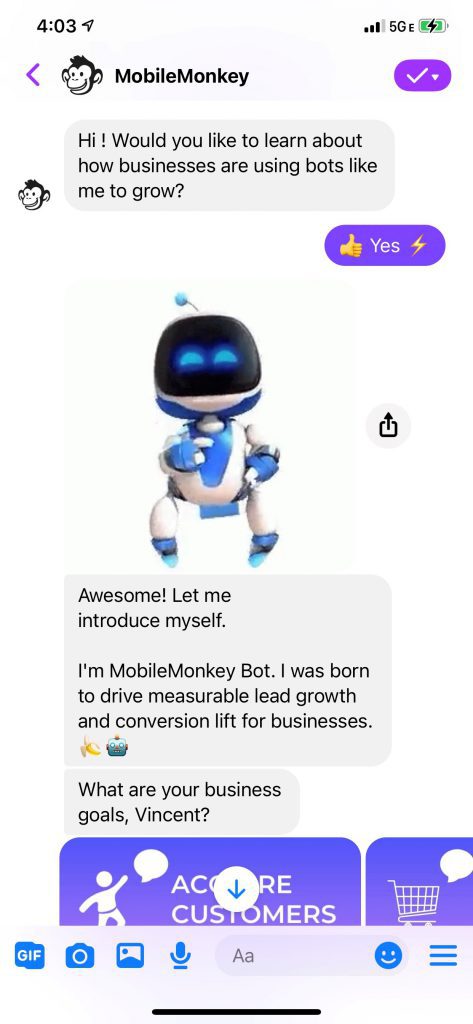
And similar to the many other benefits of running Facebook Messenger ads, is that in addition to making your ads more interactive with a higher conversion rate, you can also add lots of different content.
Different content, such as…you guessed it, GIFs!

What to know about Facebook GIF ads
- Quality matters. High-quality images and animation are the way to go for your Facebook GIF ads.
- Don’t try to do too much with your GIF ads. Keep transitions and the main message you’re attempting to convey as simple as possible.
- Less is more when it comes to using text in your GIF ads. Try to limit the use of text to your CTA (call to action) and nothing more.
- Facebook recommends using GIFs in a series instead of implementing “flashy, one-off posts.”
Facebook Ad Examples #6: Product Ads
In 2019, Facebook upgraded its original product ads and made them dynamic. Facebook Product Ads enable retailers to sync their catalog with their Facebook advertising efforts.
We already know that Google Shopping ads are incredibly powerful. Because when you’re appealing to consumers that demonstrate high commercial intent with relevant product ads, you’re sure to boost conversions.
This makes Facebook Product Ads the perfect tool for retargeting folks that have browsed your website.
The following is an example from Facebook of an auto dealer that uploaded its vehicle catalog with details such as make, model and year, then automatically generated ads that show the most compelling inventory to the right audiences.
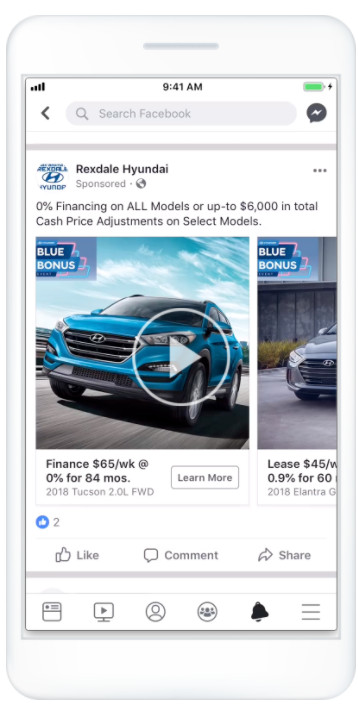
Facebook is growing its portfolio of ecommerce marketing tools. Especially with the rollout of Facebook and Instagram Shops over the course of 2020 and into 2021.
What to know about running product ads on Facebook
- Facebook Product Ads can feature either a single product, or a set of three products. Each of the featured products has its own image, description, click target, and statistics.
- Dynamic templates for Facebook Product Ads save you time by pulling images, product names, pricing, and more from your product catalog, based on the keywords you use. That also means that Facebook will stop running ads on products if they’re out of stock. That’s huge!
- If you’re thinking about running product ads, you should also be thinking about Facebook Shops. If you haven’t upgraded your business page on Facebook, now is the time to start thinking about how to use Facebook Shops for marketing and sales.
Looking to sell more on Facebook? Check out these tactics to generate immediate ROI via direct response marketing!
Facebook Ad Examples #7: Create a Sense of Urgency
Some of the best performing ads on Facebook use FOMO (fear of missing out) to create a sense of urgency.
An analysis by Neuroscience Marketing of 1,400 successful Facebook ad campaign case studies found that campaigns with purely emotional content performed about twice as well – 31% vs. 16% – as those with only rational content.

Here are some awesome tips on how to use FOMO in your Facebook ads:
- Add social proof, such as the number of people already benefitting from your product.
- Pose a question, hinting that the person’s missing out on a great opportunity.
- Make your Facebook ad offer limited by time to nudge people to sign up faster.
At Customers.ai, we ran a “last chance” Facebook Sponsored Message ad campaign for our annual Chat Marketing Conference.
Here’s how we set it up using the Customers.ai OmniChatⓇ platform:
MobleMonkey links to your Facebook Ad Account in order to set your target audience, bid and budget, as well as other Facebook tools and their parameters.
After choosing your Ad Account associated with your Sponsored Message, your target audience, and your bid/budget, you can build your Facebook Messenger ad experience.
Above you can see the first bit of dialogue along with three different options for the user to choose from. This is great for creating an interactive and engaging experience.
When your Sponsored Messages Ad is ready, you can send a Messenger blast out to your entire audience. Here’s what that looked like for those that received it.
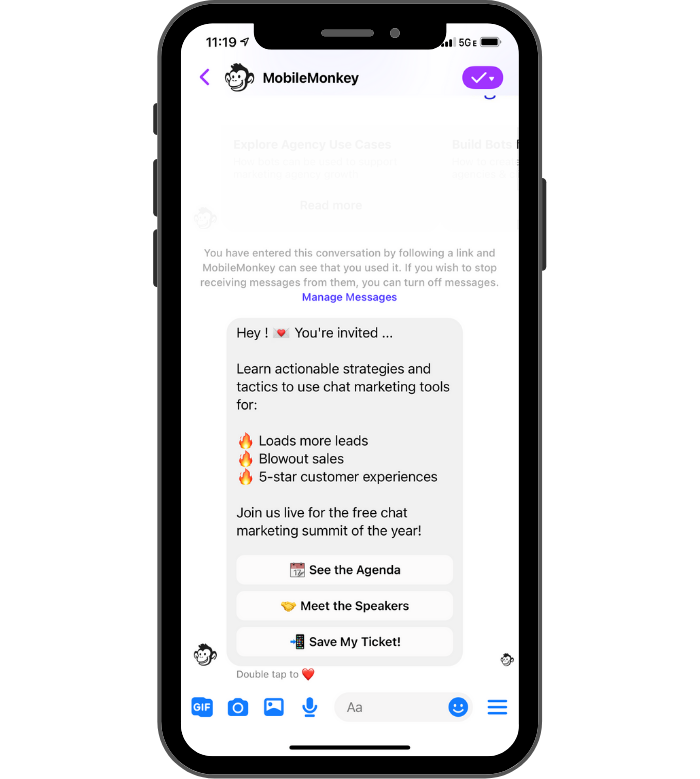
We ran a few different versions of this Messenger ad campaign. One using a sense of urgency, and one without. When we ran the ad with a sense of urgency, we significantly reduced the Cost per Result.

What to know about creating a sense of urgency with Facebook ads
- Whether a user follows through to conversion or not, you still capture their contact information with Messenger ads.
- At Customers.ai, we found that Sponsored Message ad campaigns should run at least 1 week to reach your full audience.
- Define clear dates: “Today only” or “Offer ends at Midnight”
- Offer a discount: “Get 50% off today”
- Keep your offer simple and brief.
- Place your best offer in the ad’s headline or the image.
- Match the ad’s offer to the landing page.
Facebook Ad Examples #8: Facebook Canvas Ads
Facebook canvas ads are great for increasing engagement on Facebook. And although they’ll never be as effective as they were when Facebook released canvas ads in 2016, they’re still some of the best performing ads on Facebook.
Canvas ads on Facebook are interactive video content that brands can post on their Facebook mobile pages and/or promote from the advert manager.
Creating a Canvas is like placing your landing page on Facebook. When clicked on, these ads open up in full-screen on smartphones and invite people to watch and engage.
Just take a look at this Facebook Canvas Ad from American Express and you’ll see exactly what I’m talking about:
In the ad, you’ll see arrows that help guide users through Amex’s interactive swipe video, which features scenes of eye-catching vacation spots while informing consumers or potential of all the rewards and benefits that Amex has to offer.
Canvas ads may seem like a lot of work, but they’re not, and the appeal factor for both consumers and performance marketers is very high.
What to know about Facebook Canvas ads
- Facebook Canvas ads are only for mobile users.
- You can test out Canvas ads organically.
- People don’t need to wait for the videos to load and brands don’t need to worry about poor functionality or quality, because Facebook’s already done the dirty work.
- Canvas ads are shockingly easy to make through Facebook’s ad manager and power editor.
Facebook Ad Examples #9: Brand Awareness Ads
The goal of Brand Awareness ads is to increase the recall of your ads among your target audience. So, it’s not about generating immediate sales.
Furthermore, brand awareness campaigns aren’t really suitable for smaller companies, because you need to run campaigns that drive sales quickly.
Facebook Brand Awareness Ads are not designed to completely replace direct response campaigns.
If you want to get more app installs, more website traffic, or more immediate sales, you should go with the corresponding campaign objectives.
However, instead of focusing on immediate conversions, you can also invest a proportion of your budget to brand awareness campaigns.
Doing so consistently puts your brand and your message in front of your target audience on Facebook and Instagram.
Here’s a great Facebook brand awareness ads example from Nissan:
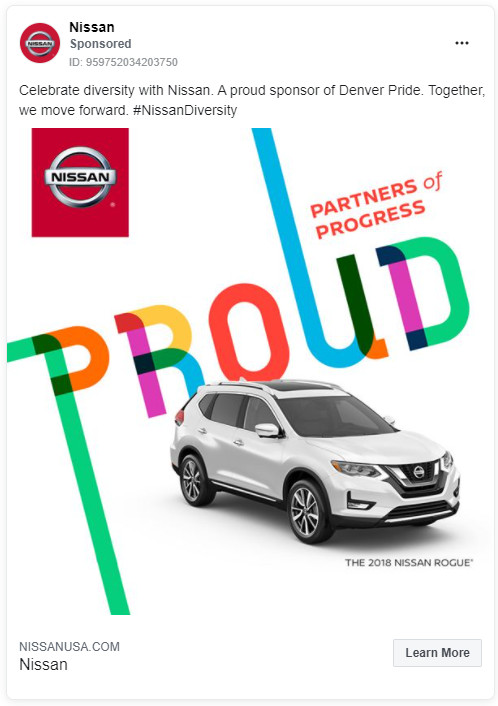
This Nissan ad was shown to a targeted audience made up of mostly women ranging from 18 to 34 years of age. Clearly, Nissan is trying to get on the good side of the younger, more progressive demographic.

What to know about Facebook brand awareness ads
- If you’re a small business, brand awareness ads probably aren’t the way to go. No worries! It’s still good knowledge and here are 31 marketing tools for small business to make up for it.
- However, also for small businesses, you can run brand awareness ad campaigns in addition to your direct response marketing campaigns (ex., website clicks, website conversions, mobile app installs, etc.).
- Facebook allows you to have a lot of control over the frequency of your brand awareness ads. You can even choose not to display the ads to the same person from 1 to 90 days.
Facebook Ad Examples #10: Advertising Hacks
One of the great Facebook hacks of all time is called the “inverted unicorn.”
This Facebook ad example had a super high CTR (click-through-rate) due to its targeting strategy. The ad targeting strategy was to take multiple unrelated interests and to target people that had all of those interests in common.
Take a look at this ad: “Life took me to England but I’ll always be an Arizona girl.”
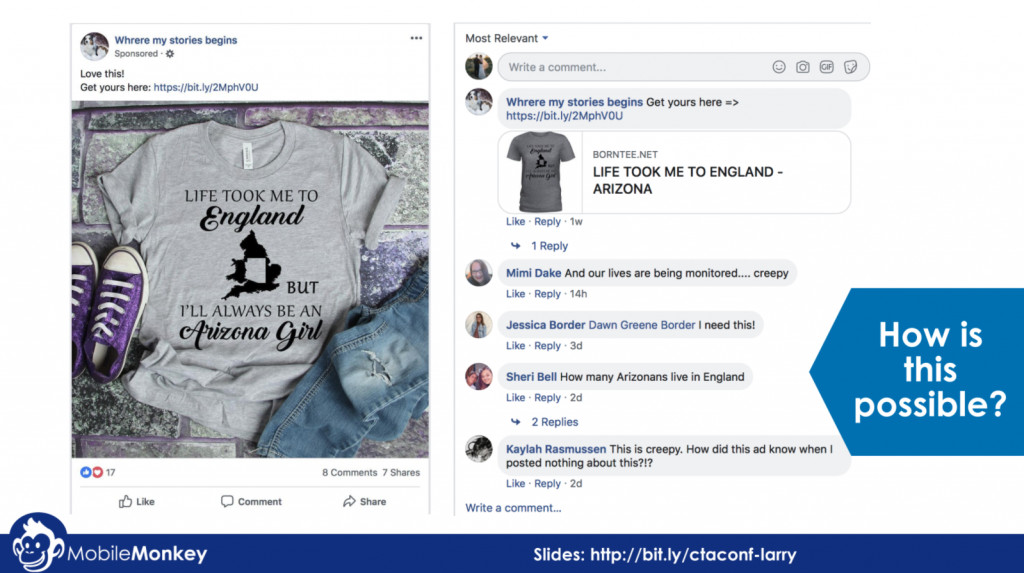
As you can see, the unrelated interests that all of the people targeted had in common were:
- Female
- From Arizona
- Recently moved to the UK
Just look at the comments to the right of the ad. People are blown away that they received such a personalized ad.
This even got the attention of major broadcast news!
Check it out, this was sent to Larry by a reporter for CNN news in the UK. She wrote to me asking how in the world she had been targeted with this ad.

But there’s nothing extremely special about this ad. Think about it.
Everyone knows that you can target by gender and location. And I’m sure most all of you know that you can target by behaviors, such as “recently moved.”
However, where this ad gets a little more complicated is how we were able to target people that were originally from Arizona. Because that’s not a filter you can add to your Facebook ad custom audience.
So, how did we do this? We targeted local likes of high schools, restaurants, sports teams, and other popular destinations located in Arizona.
These likes don’t guarantee that they are from Arizona but it is highly correlated with people from Arizona.
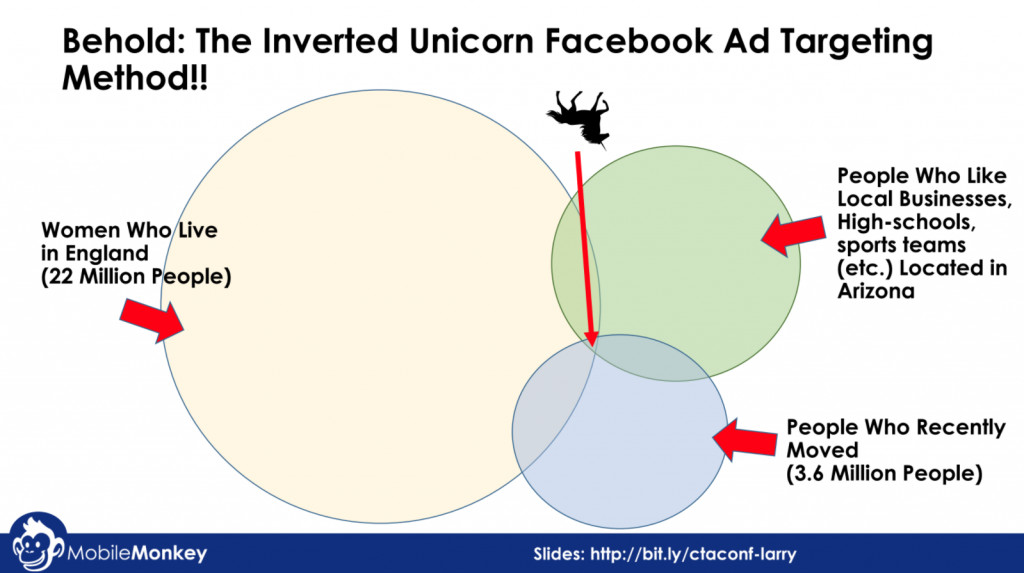
This Facebook ad hack sparks the idea of digging deeper into creative audience targeting.
In general, it’s common to target related interests. But think about what happens when you target unrelated interests.
Targeting related interests is intended to cast a net of people who like similar things as your product or service, and maybe further refining by job titles.

When creating a Facebook ad audience, In the Interests section, if you click the “suggestions” button, all of the suggestions you’ll receive will be interests that are related to your existing audience.
However, if you go for unrelated interests, crazy things happen.
The result? Remarkably higher engagement rates, comments, replies, and lower costs.
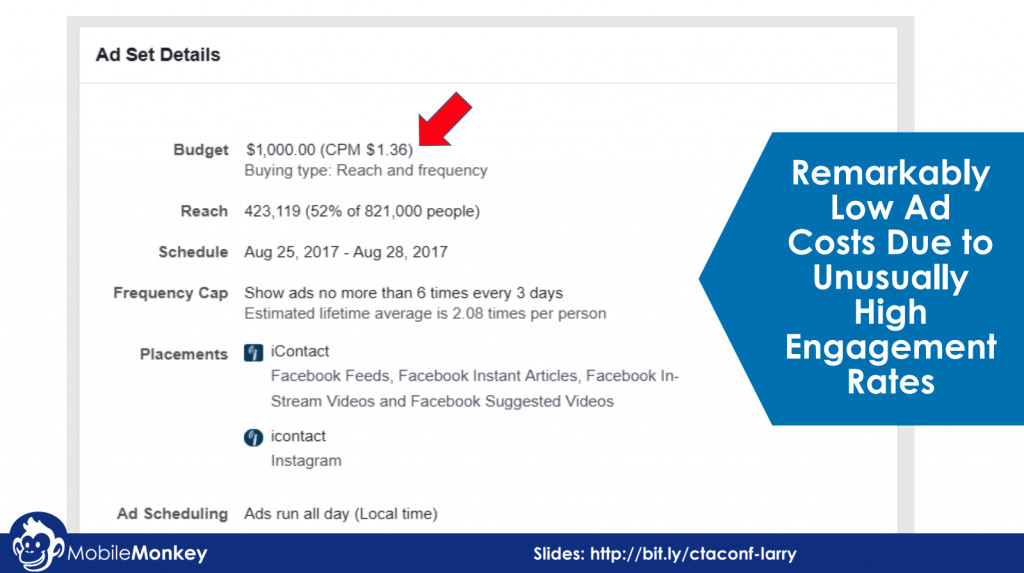
This Facebook ad example is incredibly effective at increasing the cool factor and appeal of even the most boring products or services.
Plus, if you’re working with a limited budget, you can use this method to narrow your audience and therefore reduce the cost of a campaign.
What to know about Facebook ad hacks
- If you have a large audience and need to narrow it in order to save on budget, combine unrelated interests to your targeting attributes.
- Proper growth hacking strategies are not a mistake. I’ve tried the Inverted Unicorn Ad Targeting Method countless times and it has never failed me.
- There are a lot of interesting ad targeting strategies for you to explore.
Getting Started with Great Facebook Ads
I hope you’ve learned a ton from these Facebook advertising examples. Take what you’ve learned here to create the most successful Facebook ads for your business.
If you’re looking for more amazing Facebook ad ideas, check out the Facebook campaign examples found in Larry Kim’s top Facebook ad hacks of all time.
Lastly, here are 5 Facebook Messenger Ad tips to help you get started with the best performing ads on Facebook!
Join Today’s Webinar with Larry Kim!
Or Register for the Free Replay
Learn all about NEW 100% Meta-Approved Automation Tools from Customers.ai with a spotlight on features to 10X Instagram & Facebook Engagement and turn social media into a revenue driver for your business.

Important Next Steps
FAQs about Facebook Ad Tools
Q: What are Facebook ad tools?
A: Facebook ad tools refer to a set of software or applications that help advertisers create, manage, and optimize their advertising campaigns on the Facebook platform. These tools offer various features and functionalities to target specific audiences, track ad performance, and improve campaign effectiveness.
Q: What are some popular Facebook ad tools available?
A: There are several popular Facebook ad tools available in the market, including:
- Facebook Ads Manager
- Facebook Business Manager
- AdEspresso
- Qwaya
- AdStage
These tools offer features like ad creation, targeting options, analytics, A/B testing, and automation to streamline and enhance Facebook advertising efforts.
Q: How can Facebook ad tools benefit advertisers?
A: Facebook ad tools provide several benefits to advertisers, such as:
- Efficient campaign management and optimization
- Precise audience targeting options
- Detailed analytics and reporting
- A/B testing capabilities to refine ad strategies
- Automation features to save time and effort
By leveraging these tools, advertisers can maximize the effectiveness of their Facebook ad campaigns and achieve better results.
Q: How can I get started with Facebook ad tools?
A: To get started with Facebook ad tools, follow these steps:
- Create a Facebook Business Manager account
- Set up your ad account and payment method
- Choose a Facebook ad tool that suits your needs
- Connect the tool to your Facebook Business Manager
- Explore the tool’s features and start creating and managing your ad campaigns
Each tool may have specific instructions
What makes a Facebook ad effective?
Effective Facebook ads are visually engaging, have a clear message, and include a strong call-to-action (CTA). They target the right audience and often use compelling visuals or video to capture attention quickly in a user’s feed.
How can I determine which type of Facebook ad is best for my business?
The best type of ad depends on your business goals:
- Video Ads: Great for showcasing products in action.
- Carousel Ads: Ideal for highlighting multiple products or features.
- Lead Ads: Useful for gathering contact information directly on Facebook.
- Dynamic Ads: Perfect for retargeting users based on past interactions. Assessing your objective helps determine the most effective ad format.
What are examples of engaging Facebook ad CTAs?
Effective CTAs encourage immediate action and align with the ad’s purpose. Examples include:
- “Shop Now” for product promotions.
- “Learn More” for educational content.
- “Sign Up” for event or webinar registrations.
- “Download Now” for apps or resources. These CTAs help guide users toward the intended outcome.
How do carousel ads differ from other ad types?
Carousel ads allow multiple images or videos within a single ad, each with its own link. This format is effective for showcasing product collections, features, or step-by-step guides, and it encourages interaction by letting users swipe through the visuals.
What’s the benefit of using video in Facebook ads?
Video ads are highly engaging, as they capture attention more effectively than static images. They are ideal for demonstrating product use, storytelling, or sharing testimonials. Video ads can increase viewership and are often more memorable than static formats.
How can small businesses create high-quality Facebook ads on a budget?
Small businesses can use free or affordable design tools like Canva to create professional visuals. They can also repurpose content, such as turning product photos into carousels or converting testimonials into video ads. Focusing on clear messaging and targeting the right audience is key.
What is dynamic ad retargeting on Facebook?
Dynamic ad retargeting shows ads based on a user’s previous interactions with a brand’s website or app. For example, if a customer views a specific product but doesn’t purchase, they might see an ad for that product on Facebook, encouraging them to return and complete the purchase.
How can I use storytelling in Facebook ads?
Storytelling can create a stronger connection with audiences by focusing on relatable narratives or customer experiences. For example, an ad for a fitness brand could share a customer’s journey, showing how the product helped them reach their goals. Storytelling ads often feel less promotional and more authentic.
What are examples of effective targeting for Facebook ads?
Effective targeting options include:
- Location-Based: Targeting users within a specific area for local businesses.
- Interest-Based: Reaching users interested in related products or topics.
- Custom Audiences: Retargeting previous website visitors or customers.
- Lookalike Audiences: Targeting users similar to existing high-value customers. Proper targeting ensures ads reach the most relevant audience.
How does the ad copy impact Facebook ad performance?
Ad copy is critical for conveying value and capturing attention. Short, persuasive copy with a clear benefit and CTA can improve engagement. For instance, a skincare ad might use copy like “Glow all year with our best-selling moisturizer – Shop Now!” to highlight benefits and prompt action.
What are the best practices for designing Facebook ad images?
Ad images should be high-quality, relevant, and free of excessive text. Bright colors, minimal text, and clear focus on the product or message increase the chances of catching the viewer’s eye. Testing different images can also help identify which visuals work best.
Can you give an example of a Facebook ad that drives engagement?
An example of an engaging Facebook ad might be a poll or question-based ad. A coffee brand could ask, “What’s your favorite way to start the morning?” with choices like “Espresso” or “Latte.” This approach invites interaction, helping the brand engage with its audience and gather insights.
How does ad frequency affect Facebook ad performance?
Ad frequency is the average number of times a user sees your ad. High frequency can lead to ad fatigue, where users ignore or react negatively to the ad. Ideally, monitor frequency and refresh the ad creative or audience targeting to keep engagement high without overwhelming users.
What is the role of ad placement in Facebook advertising?
Ad placement determines where ads appear, such as in the news feed, stories, marketplace, or right column. Each placement has its own best practices. For example, video ads often perform well in the news feed, while story ads are suited for visually immersive content.
What are some common mistakes to avoid in Facebook ads?
Common mistakes include:
- Broad Targeting: Reaching an audience that isn’t relevant.
- Weak CTAs: Failing to prompt users with a clear next step.
- Poor Visual Quality: Using low-quality or cluttered images.
- Overcomplicated Messaging: Not conveying a clear and direct value. Avoiding these mistakes can improve ad performance and engagement.
How can businesses test different ad creatives on Facebook?
A/B testing allows businesses to test variations of images, copy, CTAs, and targeting to see what resonates most with their audience. For example, a business could test two versions of an ad with different images or headlines and measure which one drives more engagement.
What’s the impact of Facebook ad captions on user engagement?
Captions add context to visuals and can increase engagement by providing additional information or creating curiosity. For example, a caption like “Don’t miss out on our limited-time offer!” can add urgency, prompting users to click through or learn more.
How do Facebook Lead Ads help with customer acquisition?
Facebook Lead Ads collect user information, such as email addresses, directly within Facebook. They’re particularly useful for businesses looking to grow their email list, promote events, or generate leads for services. The seamless process reduces friction, increasing form submissions.
What are some examples of Facebook ad objectives for different business goals?
Examples of ad objectives include:
- Brand Awareness: Ads designed to increase visibility, ideal for new products.
- Traffic: Ads that drive users to a website or landing page.
- Conversions: Ads that encourage specific actions, like purchases.
- App Installs: Ads promoting downloads for a mobile app. Choosing the right objective ensures the ad aligns with business goals.
How can carousel ads be used for storytelling?
Carousel ads are excellent for storytelling, as each card can represent a part of the narrative. For example, a travel company might use a carousel to show a customer’s journey, with each card highlighting a different destination or experience. This approach engages users and encourages them to swipe through the story.
